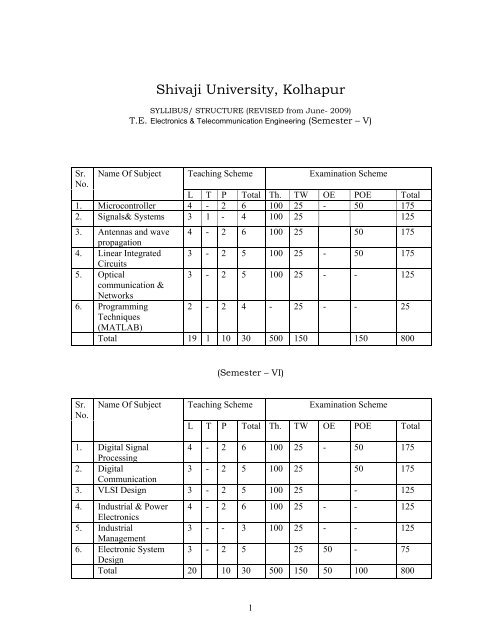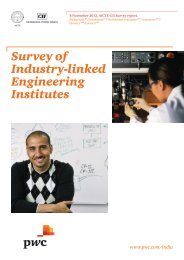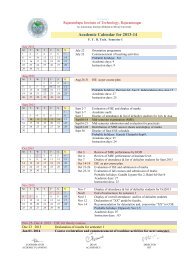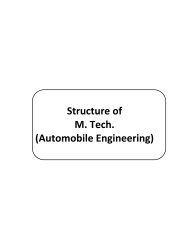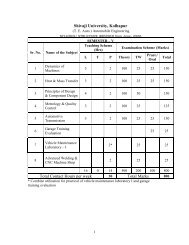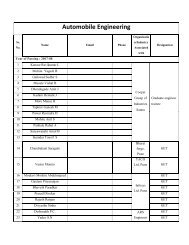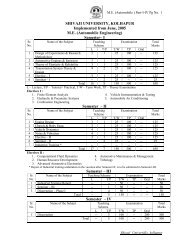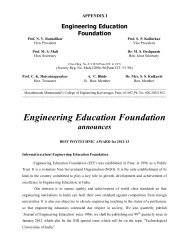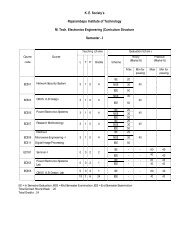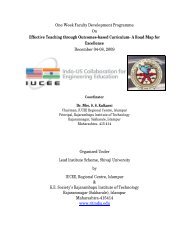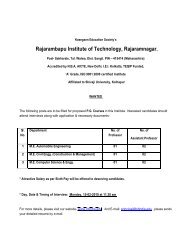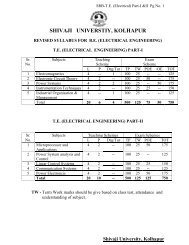Shivaji University, Kolhapur
Shivaji University, Kolhapur
Shivaji University, Kolhapur
You also want an ePaper? Increase the reach of your titles
YUMPU automatically turns print PDFs into web optimized ePapers that Google loves.
<strong>Shivaji</strong> <strong>University</strong>, <strong>Kolhapur</strong><br />
SYLLIBUS/ STRUCTURE (REVISED from June- 2009)<br />
T.E. Electronics & Telecommunication Engineering (Semester – V)<br />
Sr.<br />
No.<br />
Name Of Subject Teaching Scheme<br />
Examination Scheme<br />
L T P Total Th. TW OE POE Total<br />
1. Microcontroller 4 - 2 6 100 25 - 50 175<br />
2. Signals& Systems 3 1 - 4 100 25 125<br />
3. Antennas and wave 4 - 2 6 100 25 50 175<br />
propagation<br />
4. Linear Integrated 3 - 2 5 100 25 - 50 175<br />
Circuits<br />
5. Optical<br />
3 - 2 5 100 25 - - 125<br />
communication &<br />
Networks<br />
6. Programming 2 - 2 4 - 25 - - 25<br />
Techniques<br />
(MATLAB)<br />
Total 19 1 10 30 500 150 150 800<br />
(Semester – VI)<br />
Sr.<br />
No.<br />
Name Of Subject<br />
Teaching Scheme<br />
Examination Scheme<br />
L T P Total Th. TW OE POE Total<br />
1. Digital Signal 4 - 2 6 100 25 - 50 175<br />
Processing<br />
2. Digital<br />
3 - 2 5 100 25 50 175<br />
Communication<br />
3. VLSI Design 3 - 2 5 100 25 - 125<br />
4. Industrial & Power 4 - 2 6 100 25 - - 125<br />
Electronics<br />
5. Industrial<br />
3 - - 3 100 25 - - 125<br />
Management<br />
6. Electronic System 3 - 2 5 25 50 - 75<br />
Design<br />
Total 20 10 30 500 150 50 100 800<br />
1
Teaching Scheme :<br />
Lectures: 4 Hrs/Week<br />
Practical: 2Hrs/week<br />
TE (Electronics & Telecommunication Engineering) Semester -V<br />
1. Microcontrollers<br />
Section –I<br />
Examination Scheme:<br />
Paper: 100 Marks<br />
TW: 25 Marks<br />
POE: 50 Marks<br />
Chapter 1: Introduction to MCS 51 (08)<br />
Introduction to MCS 51 Family, Architecture, Functional Pin out diagram, Programming<br />
Model, Memory Organization, Addressing Modes, Instruction Set: Classification, Reset<br />
Circuit, Machine Cycle, Oscillator Circuit, Introduction to Assembly Language<br />
Programming.<br />
Chapter 2: Hardware overview: (06)<br />
Input/Output Ports, Counters & Timers, Serial Communication, Interrupt.<br />
Note: Structure of Above, Related S.F.R, Instruction, Associated Programs.<br />
Chapter 3: Interfacing & Application (06)<br />
Interfacing: RAM, ROM, LCD, ADC, DAC, Key board. Minimum System Design &<br />
Application: Interfacing of Temperature Sensor (LM 35) 8051 Connection to RS 232.<br />
Note: Assembly Language Programming to be done using Keil or Pinnacle Simulator<br />
Section-II<br />
Chapter 4: Introduction to PIC family (08)<br />
CPU Architecture: Harvard architecture & pipelining, program memory considerations<br />
Register file structure, Instruction set, addressing modes: Immediate, Direct, Indirect CPU<br />
Registers: Status, W, FSR. INDF, PCLATH, PCL, Programming of above<br />
Chapter 5: Hardware Overview: (06)<br />
a. I/O ports &TRIS registers.<br />
b. External Interrupts, Timers, CCP Module: Programmable period scalar, Event Counter,<br />
Sleep Mode, PWM mode<br />
c. ADC: Features, ADC use.<br />
[Note: Structure related to above, SFR’s Simple programs]<br />
Chapter 6: Special features: (06)<br />
Configuration word, Oscillator configuration, Reset alternatives, low power operation,<br />
concept if I 2 C & associated Hardware<br />
[Note: Syllabus need to be covered with reference to PIC 16FX]<br />
Note: Programming of PIC to be done using MPLAB or similar software.<br />
Text Books:<br />
1. The 8051 Microcontroller By Ayala 3 rd Edition<br />
2. The 8051 Microcontroller & Embedded Systems<br />
By Muhammad Ali Mazidi & Janice Gillispie Mazidi Pearson Edition L.P.E.<br />
3. Design with PIC Microcontroller by John B. Peatman, Person Education.<br />
4. Microchip PIC 16FX family microcontroller data sheet<br />
Reference Books:<br />
2
Term Work:<br />
1. Architecture Programming, Interfacing & System design<br />
By Rajkamal Pearson edition.<br />
2. The 8051 Microcontroller & Embedded Systems<br />
By Muhammad Ali Mazidi & Janice Gillispie Mazidi Pearson Second Edition<br />
3. Programming the PIC microcontroller with MBASIC By Jack R. Smith<br />
Minimum 10 experiments should be conducted<br />
5 experiments on MCS 51 family Microcontroller & 5 experiments on Microchip PIC<br />
Microcontroller should be performed. Minimum 50% experiments to be performed on<br />
microcontroller kits.<br />
3
Teaching Scheme :<br />
Lecturers : 3 hr/week:<br />
Tutorial : 1hr/week<br />
TE (Electronics & Telecommunication Engineering) Semester -V<br />
2. Signals & Systems<br />
Section-I<br />
4<br />
Examination Scheme:<br />
Theory : 100 Marks<br />
Term Work: 25 Marks<br />
Unit-I: Introduction to Signals: (06)<br />
Definition of signals, classification of signals: continuous time signals & discrete time signals,<br />
even & odd signals, periodic & non-periodic , deterministic & non-deterministic, energy &<br />
power,elementary signals: unit impulse, unit step, unit ramp, exponential & sinusoidal , basic<br />
operations on signals.<br />
Unit-II. Linear time- invariant systems: (08)<br />
The representation of signals in term of impulses, discrete time LTI systems, the convolution<br />
sum, continuous time-LTI systems, The convolution integral, properties of linear time invariant<br />
systems, Systems described by differential, difference equations, block diagram representation<br />
of LTI systems described by differential difference equations, Singularity functions.<br />
Unit-III: Z transform: (08)<br />
Introduction of Z-transform, ROC, properties of ROC, Unilateral Z-transform, properties of Z<br />
transform:linearity, time shifting, time reversal, time scaling, convolution, differentiation,<br />
multiplication, Parsevals theorem, initial value & final value theorem. Inverse Z-transform: PFE<br />
method, long division method, residue method, convolution method. Transfer function(Poles &<br />
Zeros), stability and causality. Representation of system via difference equation and solution of<br />
it.<br />
Section-II<br />
Unit-IV: Fourier Series for Continuous Time & Discrete Time: (08)<br />
Continuous time & discrete time Fourier series: development Fourier of Series,<br />
derivation,properties of Fourier series: linearity, time shifting, frequency shifting, time reversal,<br />
time scaling,time differentiation & time integration, multiplication , convolution.<br />
Unit-V: Continuous Time & Discrete Time Fourier Transform: (08)<br />
Basic concept of Fourier transform of functions: rectangular, impulse, signum. Properties of<br />
Fourier transform: linearity, time shifting, frequency scaling, time scaling, multiplication, and<br />
convolution.<br />
Unit-VI:. Sampling: (04)<br />
Representation of continuous time signals by its samples, The sampling theorem, Reconstruction<br />
of signals from its samples using interpolation, The effect of under sampling, aliasing, Discrete<br />
time processing of continuous time signals, Sampling in the frequency domain.<br />
Text Books:<br />
1. Simon Haykin, Barry Van Veen- ‘Signals & system’ - IInd Edition Wiley publication<br />
2. Michael J. Roberts.-‘Fundamentals of signals & systems’- Tata McGraw Hill, 2007.<br />
Reference Book:<br />
1. Alan V. Oppenheim, Alan S. Wilsky, S. Hamid Nawab -‘Signals & system’ -IInd Edition -<br />
Pearson Education.<br />
2. H.A HSU, ‘Signals & system’ (Schaum’s out lines), Tata McGraw Hill<br />
3. Smarajit Ghosh, ‘Signals & system’ Pearson Education.
4. Charles L. Philips, John M. Parr, Eve A. Rislein ‘Signals, system & transform’ , IIIrd Edition,<br />
Pearson Education.<br />
5. Ramesh Babu ‘Signals & system’ , SciTech Publication.<br />
6. Benoit Boulet ‘Fundamentals of signals & System’ Thomsan Learning<br />
Term work:<br />
Term work shall consist of minimum 12 assignments, out of which minimum 05 problems to be<br />
solved on graph paper.<br />
5
TE (Electronics & Telecommunication Engineering)<br />
Semester -V<br />
3. Antenna And Wave Propogation<br />
Teaching Scheme :<br />
Lectures: 4 Hrs/Week<br />
Practical: 2Hrs/week<br />
Examination Scheme:<br />
Paper: 100 Marks<br />
TW: 25 Marks<br />
POE: 50 Marks<br />
Section I<br />
UNIT 1: INTRODUCTION TO ANTENNA (06)<br />
Basic antenna parameters, pattern, beam area, radiation inversity, beam efficiency, directivity ,<br />
gain and resolution, antenna aperture, effective height the radio communication link, field from<br />
oscillating dipole, antenna field zone, shape-impendance consideration, linear elliptical<br />
polarization poynting vector for elliptically and circularly polarized waves, The polarization<br />
ellipse & the poincare sphere, loops, dipoles and slots, opened-out coaxial line antennas,<br />
opened-out-2conductor antennas, opened out waveguide antennas, flat-sheet reflector antennas,<br />
parabolic dish and dielectric lens antennas, end fire antennas, Broad bandwidth antennas, the<br />
patch antennas.<br />
UNIT 2: ANTENNA ARRAYS: (05)<br />
Array of two isotropic point sources, nonisotropic but similar point source and the principle of<br />
pattern multiplication, examples of pattern synthesis by pattern multiplication, nonisotropic and<br />
dissimilar point sources, linear array of n isotropic point source of equal amplitude and spacing,<br />
null directions for array of n isotropics point sources of equal amplitude and spacing effect .<br />
UNIT 3: BROADBAND & FREQUENCY INDEPENDENT ANTENNA : (05)<br />
Broadband basics, infinite and finite biconical antennas, directional biconicals, conicals, disk<br />
cones and bow ties, the frequency-independent concept: rumesay’s principle, the Illinois story,<br />
the frequency independent planner log-spiral antenna, frequency independent conical-spiral<br />
antenna, the log periodic antenna, the composite yagi-uda corner-log-periodic array.<br />
UNIT 4: ANTENNA FOR SPECIFIC APPLICATIONS (05)<br />
Electrically small antenna, physically small antennas, antenna siting and the effect of<br />
typical(Imperfect) ground, ground plane antennas, sleeve antennas, turnstile antennas,<br />
superturnstile antennas, other omnidirectional antennas, circularly polarized antennas, the high<br />
gain omni, submerged antennas, surface wave and leaky wave antennas, antenna design<br />
consideration for satellite communication, receiving versus transmitting considerations,<br />
bandwidth considerations, architecturally acceptable antennas, ILS(Instrument Landing<br />
System), The LEO satellite link antenna.<br />
Section II<br />
UNIT 5: RADIATION (05)<br />
Potential functions and the electromagnetic field, potential functions for sinusoidal oscillations,<br />
the alternating current element, power radiated by current element, application to short<br />
antennas, assumed current distribution, radiation from a quarter wave monopole and the half<br />
wave dipole, sine integral and cosine integral, electromagnetic field close to an antenna,<br />
solution of the potential equations, far field approximation.<br />
6
UNIT 6: GROUND WAVE PROPOGATION (05)<br />
Plane earth reflection, space wave and the surface wave, the surface wave, elevated dipole<br />
antennas above a plane earth, wave tilt of the surface wave, spherical earth propagation,<br />
tropospheric wave.<br />
UNIT 7: IONOSPHERIC PROPOGATION (05)<br />
The ionosphere, effective permittivity and conductivity of an ionized gas, reflection and<br />
refraction of the waves by the ionosphere, regular and irregular variations of ionosphere,<br />
attenuation factor, sky wave transmission calculations, effect of earth magnetic field. wave<br />
propagation in ionosphere, Faraday rotation and measurement of total electron content, other<br />
ionospheric phenomena.<br />
UNIT 8: RADAR SYSTEM (04)<br />
Fundamentals, RADAR performance factors, basic pulsed radar system, antennas and scanning,<br />
display methods, pulsed radar systems, moving target indication, radar beacons, CW Doppler<br />
radar, frequency modulated CW radar, phase array radars, plannar array radars.<br />
Text Book:<br />
1)Antenna for all Application- John D Kraus,third edition- TMH publication<br />
2)Electronics Communication System- Keneddy Davis- 4th edition TMH publication<br />
3) Electromagnetic Waves and Radiation Systems - Jordan and Balmain PHI publ.<br />
Reference Books:<br />
1) Microwave Devices and circuits – Samuel Liao (Pearson)<br />
2) Networks, Lines and fields – John Rider ( PHI)<br />
3) Foundations of Antenna Theory and Techniques – Vincent F. Fusco (Pearson)<br />
4) Antennas and Wave Propagation – G. S. N. Raju ( Pearson)<br />
Term Work:<br />
Minimum 08 experiments should be conducted.<br />
7
Teaching Scheme :<br />
Lectures: 3 hours/ Week<br />
Practical: 2 hours/Week<br />
TE (Electronics & Telecommunication Engineering) Semester -V<br />
4. Linear Integrated Circuits<br />
Examination Scheme:<br />
Theory:100marks<br />
Termwork:25 Marks<br />
POE : 50 Marks<br />
Section-I<br />
Unit1: Introduction to op-amp (08)<br />
Introduction to op-amp: definition, symbol, block diagram, ideal characteristics of Op-amp, AC<br />
& DC analysis of dual input balanced output type differential amplifier. Comparative study of<br />
other configurations of differential amplifiers, Analysis of typical op-amp, equivalent circuit,<br />
op-amp parameters, equivalent circuit of op-amp, study of IC 741, CA3140<br />
Unit 2: Op-amp configurations & frequency response: (04)<br />
Open loop configuration, closed loop configurations, frequency Response, Stability<br />
considerations, Frequency Compensation, Slew Rate.<br />
Unit 3: Applications of Op-amp (08)<br />
Summing, Scaling & Averaging Amplifiers using Op-amps, Differential amplifier using opamp,<br />
Subtract or Circuit, Instrumentation amplifier, V to I & I to V Converter, Precision<br />
Rectifiers, Log & Anti-log Amplifiers, Study of comparator, Schmitt Trigger, Window<br />
Detector, Clippers & Clampers, Peak Detectors, Sample & Hold Circuits.<br />
Section-II<br />
Unit 4: Active Filters (08)<br />
Introduction of filters, Analysis & Design of following filters, First & Second order High Pass<br />
filter, First & Second order Low Pass filter, Band Pass filter (Narrowband & Wideband), Band<br />
Reject filter (Narrowband & Wideband), All Pass Filter, Sallen & Key Filter Structure (First &<br />
Second order), Chebyshev Filter.<br />
Unit 5: Waveform Generators (08)<br />
Analysis & Design of Square wave generator, Triangular wave generator, Sawtooth wave<br />
generator. Analysis & Design of RC phase shift oscillator, RC wein bridge oscillator, Colpitts<br />
oscillator, Hartley oscillator, Crystal oscillator, Multivibrator using op-amp.<br />
IC 555 Timer, Block Diagram, Multivibrator using IC 555.<br />
Unit 6: PLL (04)<br />
Operating Principles, VCO-IC 566, PLL IC 565, PLL IC 565 applications, IC 4046<br />
Text Books:<br />
1. Op-amp & Linear Integrated Circuits by Ramakant Gaykwad. 4th ed. Pearson<br />
Publications.<br />
Reference Books:<br />
1. Microelectronic Circuits Analysis & Design by Rashid<br />
2. Linear Integrated Circuits Analysis , Design & Applications by Nair<br />
3. linear integrated circuits-GANESH BABU(SCITECH PUB)<br />
4. Op-amp & LIC-K.LAL KISHOR<br />
Term Work: Minimum 08 experiments should be conducted.<br />
8
TE (Electronics & Telecommunication Engineering) Semester -V<br />
5. Optical Communication & Networks<br />
Teaching Scheme :<br />
Lectures: 3 Hrs/Week<br />
Practical: 2Hrs/week<br />
Section - I<br />
Examination Scheme:<br />
Paper: 100 Marks<br />
TW: 25 Marks<br />
Unit – I: Overview of Optical Fiber Communication (3)<br />
Basic Network Information Rates, The evolution of Optic System, Elements of<br />
Optical Fiber Transmission Link, Simulation and Modeling tools.<br />
Unit – II: Optical Fibers: Structures, Waveguiding and Fabrication (6)<br />
The nature of Light, Basic Optical Laws and Definations, Optical Fiber Modes<br />
and Configurations, Mode theory for waveguides, Single Mode Fibers, Graded<br />
Index Fiber Structures, Fiber Materials, Fiber Fabrication, Mechanical<br />
Properties of Fibers, Fiber Optic cables.<br />
Unit – III: Signal Degradation in Optical Fibers (4)<br />
Attenuation, Signal Distortion in Optical Waveguides, Pulse Broadenning in<br />
Graded-Index Waveguides, Mode Coupling, Design Optimization of Single<br />
Mode Fibers.<br />
Unit – IV: Optical Sources (5)<br />
Topics from Semiconductor Physics, Light-Emitting Diodes (LEDs), Laser<br />
Diodes, Light Source Linearity, Modal, Partition and Reflection Noise,<br />
Reliability Considerations.<br />
Section - II<br />
Unit – V: Photodetectors (4)<br />
Physical Principal of Photodiodes, Photodetector Noise, Detectors Response<br />
Time, Avalanche Multiplication Noise, Structure for InGaAs APDs,<br />
Temperature effect of Avalanche Gain, Comparision of Photodetectors<br />
Unit – VI: Optical Receiver Operation (4)<br />
Fundamental Receiver Operation, Digital Receiver Performance, Detailed<br />
Performance Calculations, Preamplifier Types, Analog Receivers.<br />
Unit – VII: WDM Concepts and Components (4)<br />
Operational Principles of WDM, Passive Components, Tunable Sources,<br />
Tunable Filters<br />
Unit – VIII: Optical Networks (6)<br />
Basic Networks, SONET/SDH, Broadcast-and –Select WDM Networks,<br />
Wavelength Routed Networks, Nonlinear Effects on Network Performance,<br />
Performance of WDM + EDFA Systems, Solitons, optical CDMA, Ultrahigh<br />
capacity Networks.<br />
Note: Termwork shall consist of minimum 8 experiments based on above topics.<br />
Text Books : 1) Optical Fiber Communication – Gerd Keiser. Third Edition ( TMH )<br />
Ref. Books: 1) Optical Communication – Senior<br />
2) Optical Fiber Communication – Agarwal ( Wiley)<br />
3) Optical Fiber Communication - Grover<br />
4) Optical Networks - Ramaswamy ( ELSEVIER INDIA )<br />
9
TE (Electronics & Telecommunication Engineering) Semester -V<br />
6. Programming Techniques (MATLAB)<br />
Teaching Scheme<br />
Examination Scheme<br />
Lectures : 2 hours/week<br />
Practical : 2 hour/week Term work : 25 marks<br />
UNIT- I (05)<br />
Matlab basics variables, arrays , Multidimensional subarrays , Special values, displaying<br />
output data, data files, scalar and array operations, Hierarchy of operations built-in matlab<br />
functions, introduction to plotting, Debugging matlab programs.<br />
UNIT- II (04)<br />
Branching, Statements and logical data type, Branches, write & for loop logical arrays and<br />
vectorization<br />
UNIT- III (05)<br />
User-defined& i/o functions, introduction to matlab functions, Variable passing in matlab, 3<br />
optional arguments, Sharing data using global memory, Preserving data between calls to a<br />
function, function functions, subfunctions, Private functions, Nested functions . complex<br />
data , string functions , textread function, load and save commands, an introduction to<br />
matlab file processing, file opening and closing , binary i/o functions, formatted i/o<br />
functions, comparing formatted and binary i/o function, file positioning and status functions<br />
UNIT- IV (03)<br />
Handle graphics & gui , the matlab graphics system, Object handles, examining and<br />
changing object properties, Using set to list possible property values, user-defined data,<br />
finding objects, selecting objects with the mouse, creating and displaying a graphical user<br />
interface, object properties, graphical user interface components, dialog boxes , menus..<br />
UNIT- V (03)<br />
Simulink basics introduction, simulink, modeling, solvers, simulating model using variables<br />
from matlab, data import/export , state space modeling & simulation, creation of<br />
subsystems,& Mass subsystem.<br />
Text Books-<br />
1) MATLAB programming for engineers- IIIrd edition- Stephen J. Chapman-Cenage Learning<br />
2) MATLAB & its application in engineering Rajkumar Bansal, Ashokkumar Good,<br />
Manojkumar Sharma- Person Education<br />
3) MATLAB & Introduction with application Amos Gilat-Wiley<br />
Reference Books-<br />
1) Master in MATLAB-7 Duane Hanselman, Bruce Littlefiele- Person Education<br />
2) MATLAB programming manual by Mathworks Inc<br />
3) MATLAB & simulink Introduction to applications.- Partha S.Mallick-Scitech publications.<br />
10
List of MATLAB programs<br />
1) Program using branching statement<br />
2) Program using looping statement<br />
3) Program for matrix manipulation<br />
4) Program using user defined function<br />
5) Program for handling complex data<br />
6) Program for File handling & string manipulation (Any two)<br />
7) Program for creating & Displaying GUI (Any two)<br />
8) Mini project based on any Engineering applications.( It should be completed within<br />
Two or Three terms<br />
11
TE (Electronics & Telecommunication Engineering) Semester -VI<br />
1. Digital Signal Processing<br />
Teaching Scheme<br />
Examination Scheme<br />
Lectures : 4 hours/week Theory :100 marks<br />
Practical : 2 hour/week Term work :25 marks<br />
POE : 50 Marks<br />
Section I<br />
UNIT-I:The Discrete Fourier Transform and FFT (08)<br />
Introduction to DSP system, DFT, Relation between DFT and Z Transform. Properties of<br />
DFT, Circular convolution, DFT. & IDFT<br />
FFT algorithms (DIT FFT & DIF FFT) implementation aspects, fast convolution signal,<br />
segmentation (overlap save & overlap-add algorithm) correlation circular correlation,<br />
IFFT,DFT properties of circular correlation.<br />
UNIT-II : FIR Filter Design (06)<br />
Characteristics of FIR filter, properties of FIR filter, digital N/W for FIR filter, frequency<br />
sampling ,Fourier series & windowing method, filter design using Kaiser window,<br />
Realization of FIR direct form structures cascade, parallel<br />
UNIT-III : IIR Filter Design. (06)<br />
Impulse invariant Tech. Bilinear transformation, Placement of poles & zeros, frequency<br />
band transformation, analog filter approximation (Butterworth) quantization and rounding<br />
problems, Effect of finite word length on stability and frequency response., Realization of<br />
IIR direct form structures cascade, parallel<br />
Section II<br />
UNIT-IV: Adaptive filters (04)<br />
Introduction to adaptive signal processing, Adaptive direct form FIR filters- LMS algorithm<br />
UNIT-V: DCT & wavelet Transform (10)<br />
Forward DCT, Inverse DCT, DCT as a orthogonal transformation.<br />
Introduction to wavelets, time frequency representations, continues time wavelet, Continues<br />
wavelet transform (CWT), Inverse CWT, Properties of CWT, Discrete wavelet transform,<br />
STFT, Comparison of Fourier transform & wavelet transform ,Application of wavelets<br />
transforms .<br />
UNIT-VI : Application of Digital Signal Processing (06)<br />
Voice processing Analysis of speech signal, Speech analysis, Synthesis, System<br />
compression and coding channel vocoder, Sub band and coding<br />
Image processing, Biomedical signal processing - ECG<br />
12
Text Books-<br />
1. Digital Signal Processing Principles, Algorithms and Application<br />
By John G Prokis, Manolakis, Pearson Education publication<br />
2) Digital Signal Processing Salivahanam, A Vallavaraj, C. Guanapriya, TMH<br />
Ref. Books<br />
1) Digital Signal Processing P. Ramesh Babu, Scitech publication<br />
2) Digital Signal Processing Sanjeet Mitra, MGH<br />
3) Digital Signal Processing- E.C. Ifeachor, Barrie W. Jervis<br />
4) Digital Signal Processing- Ashok Ambardar, ( Cengage learning)<br />
5) Digital Signal Processing- Dr. S.D.Apte, Willey India<br />
List of Experiments.<br />
Minimum 10 experiments<br />
Experiments may be performs using Matlab/DSP simulator<br />
1. Generation of DT signals<br />
2. Convolution and correlation of signals<br />
3. Computation of DFT & IDFT using standard formula<br />
4. Computation of DFT using FFT algorithms<br />
5. Computation of circular convolution<br />
6. Design of FIR LPF,HPF,BPF,BRF filter using Fourier series method<br />
7. Design of FIR LPF,HPF,BPF,BRF filter using frequency sampling method<br />
8. Design of FIR filter using Kaiser window<br />
9. Design of IIR LPF,HPF,BPF,BRF filter using impulse invariance method<br />
10. Design of FIR LPF,HPF,BPF,BRF filter using bilinear transformation method<br />
11. Design IIR filter using placement of poles & zeros.<br />
12. Computation of DCT<br />
13. Computation of wavelet transform<br />
13
TE (Electronics & Telecommunication Engineering) Semester -VI<br />
2. Digital Communication<br />
Teaching Scheme :<br />
Examination Scheme:<br />
Lectures – 3/week Theory – 100<br />
Practical – 2/week POE – 50<br />
TW - 25<br />
Section - I<br />
Unit – I: Random Signal Theory: (06)<br />
Probability, Joint & conditional Probability, Probability mass function, statistical averages,<br />
continuous random variables- PDF & Statistical averages, Random Processes, Time average,<br />
Ergodicity, Power Spectral density of Stationary random processes.<br />
Unit – II: Information Theory: (06)<br />
Entropy, Information Rate, Shannon’s encoding theorem, communication channels- Discrete<br />
& Continuous, Rate of information transmission over a discrete channel, Shannon–Hartly<br />
theorem, implication of Shannon’s Theorem, Huffman’s coding & Shannon-Fanno Coding<br />
techniques.<br />
Unit – III: Source Coding: (06)<br />
Quantization – Uniform, Non- Uniform, PCM, DPCM, ADPCM, Bandwidth Requirement,<br />
SNR, DM, ADM, CVSD.<br />
Section – II<br />
Unit – IV: Digital Modulation Techniques and data formats: (06)<br />
Unipolar, Bipolar ,RZ , NRZ, Transmission modes<br />
ASK, FSK, PSK - coherent, Non- coherent, BPSK, DPSK, QAM. Comparision.<br />
Unit – V: Baseband Transmission: (05)<br />
Baseband pulse Shaping, Duobinary, M-ary Signalling, Pulse Shaping by digital methods,<br />
eye diagram, ISI, scrambler, Unscrambler.<br />
Optimum Receivers- Matched Filters, Correlation receivers, equalizers, Symbols & frame<br />
synchronization.<br />
Unit –VI: Channel Coding (07)<br />
Types of Erros & codes, linear block codes, error detection & correction, Hamming codes,<br />
Look-up table decoding., Binary Cyclic codes, Encoding using (n-k) bit shift registers,<br />
Syndrome calculation. BCH, Burst codes, Convolution codes, Encoders, Decoders, Code<br />
tree.<br />
Books:<br />
1) K. Sam Shanmugam – Digital & Analog Communication ( John Wiley)<br />
2) Simon Haykin – Digital Communication (Wiley)<br />
EXPERIMENT LIST : (Minimum 10 Experiments)<br />
1. Study of PCM –TDM.<br />
2. Study of Compander.<br />
3. Study of DPCM.<br />
4. Study of ADPCM.<br />
5. Study of DM .<br />
14
6. Study of ADM.<br />
7. Study of CVSD.<br />
8. Study of ASK, FSK & PSK.<br />
9. Study of QPSK.<br />
10. Measurement of bit error rate.<br />
11. Study of Hamming Code.<br />
12. Study of generation of cyclic codes.<br />
13. Study of Eye Diagram using oscilloscope<br />
14. Study of any digital modulation scheme using Matlab communication tool<br />
15. Matlab practicals on random signals (Study of Continuous Random<br />
Variable- probability, variance)<br />
15
TE (Electronics & Telecommunication Engineering) Semester -VI<br />
3. VLSI Design<br />
Teaching Scheme :<br />
Examination Scheme:<br />
Lecture:- 3 hrs/ week .<br />
Theory- 100 marks<br />
Practical :- 2hrs/ week .<br />
TW - 25 marks<br />
Section- I<br />
Unit 1 :- Introduction to VHDL (04)<br />
Level of abstraction. Need of HDL, VLSI Design flow, Features and capabilities of VHDL,<br />
Elements of VHDL ( Entity Architecture , Library, Package, Configuration) , Identifiers,<br />
literals, data types,operators.<br />
Unit 2 :- Combinational logic design using VHDL ( 07)<br />
Adder, subtractor, decoder, encoder, tristate buffer, multiplexer, parity generator, Parity<br />
checker, comparator, using Concurrent & Sequential statements, wait statement, VHDL<br />
design of encoder & decoder - for Huffman code, Shannon-fano code, Hamming code, BCH<br />
code, Design for ALU.<br />
Unit 3:- FSM Design Using VHDL (07)<br />
Impediments to synchronous design, clock jitter, skew, gating the clock, asynchronous<br />
inputs, meta-stability and synchronizer failure, VHDL implementation of counter, sequence<br />
detector, Design of content addressable memory CAB.<br />
Section- II<br />
Unit 4:- VHDL Features (04)<br />
Attributes (type, signal, signal value, array, block), wait statement, Simulators,<br />
Event based simulator, Cycle based simulator, Flow chart for Event scheduling and delays,<br />
inertial delay, Transport delay.<br />
Unit 5:- Processor Design (07)<br />
Design of General purpose processors- having instructions like LOAD, STORE, ADD,<br />
SUB, IN, JZ, JPOS, HALT. Design of Data path, design of control unit, test bench using text<br />
IO.<br />
Unit 6:- PLD Architectures and Testing (07)<br />
Xillnx 9500 series CPLD (XC 9572), Spartan II FPGA (XCS 2 s30), Testing : Fault models,<br />
path sensitizing random test design for testability, Built-in self test and Boundary scan.<br />
Referances Books:-<br />
1. Fundamentals of Digital Logic with VHDL design , Tata – Mcgraw Hill- Stephen<br />
Brown and Zvonko Vranesic<br />
2. Principals of Digital System Design using VHDL, Cengage Learning -Roth John.<br />
3. Digital Systems Design with VHDL and Synthesis An Integrated Approach, Wiley-<br />
India Editio - K.C. Chang.<br />
4. Xilinx data manual “ The Programmable Logic data Book”<br />
5. VHDL a Design Oriented approach , Mcgraw-hill Compnies - S.S.Limaye.<br />
6. Digital logic and microprocessor design with VHDL - Thomson Publication- Enoch O.<br />
Hwang.<br />
16
Practicals :<br />
LAB Setup :<br />
Model Tech. Modelsim simulator and Xillinx Web pack, Xilinx ISE Simulator VLSI universal<br />
trainer for FPGA and CPLD of Xilinx<br />
Experiments :<br />
Minimum 08 experiments based on following design . Each design must be tested through<br />
VHDL test bench.<br />
Simulation, Synthesis, and Implementations using FPGA and CPLD Trainers:<br />
1. Combinational logic : comparator, adder, barrel shifter, encoder & decoder for<br />
communication codes.<br />
2. Sequential logic : Counters withsync./async. Reset signal, universal shift<br />
registers,sequence detector, arbiter, LFSR.<br />
3. Singal port RAM Dual port RAM, Singal port RAM , FIFO<br />
4. General purpose processor, ALU.<br />
17
TE (Electronics & Telecommunication Engineering) Semester -VI<br />
4. Subject : Industrial & Power Electronics.<br />
Teaching Scheme :<br />
Lectures: 4 Hrs/week<br />
Practicals: 2 Hrs/week<br />
Examination Scheme:<br />
Theory: 100 marks.<br />
TW : 25 marks<br />
Section-I<br />
1. Semiconductor Power Devices : - (06)<br />
Characteristics of power diodes, power transistors, power MOSFET, IGBT, SCRs, TRIACs,<br />
DIAC and GTO. Rating of power devices, series and parallel connections of SCRs, SCR<br />
protections- dv/dt, di/dt, over voltage and over current protection.<br />
2. Firing circuits : - (04)<br />
Turn ON Methods- study of single phase firing circuits using UJT, PUT, Diac, Triac, op amp.<br />
Turn OFF Methods - Forced commutation circuits - Parallel Capacitance, resonant turn off,<br />
external pulse commutation, auxillary thyristors/IGBT/ MOSEFT and load commutation.<br />
(Class A to F)<br />
3. Applications of Thyristors : - (03)<br />
Static circuit breakers, over voltage protectors, zero voltage switch, integral cycle triggering,<br />
time delay method, soft start method.<br />
4. Controlled Rectifier Circuits : - (07)<br />
a) Single Phase : - Half wave, full wave, half controlled and full controlled converters with R &<br />
RL Load, effect of Freewheeling Diode. Calculations of performance parameters expected.<br />
b) Three Phase: - Half wave, full wave, fully controlled converters with Resistive Load only.<br />
Section-II<br />
5. Inverters using MOSFET/IGBT’s: - (04)<br />
Single phase bridge inverters, principle and operation of three phase inverters, Voltage control<br />
techniques, harmonic elimination methods -PWM Technique IGBT MOSFET based (Analytical<br />
treatment not expected )<br />
6. AC and DC Drives : - (04)<br />
a) DC Motor control- using single phase bridge converters, dual converters and choppers<br />
b) 3-phase AC motor control- speed control of Induction Motor using Inverter, Study of<br />
modern 3 – φ drives.<br />
7. Programmable Logic controllers (PLC’s) - Ladder diagram, (06)<br />
Fundamentals, symbol, PLC configurations, Block diagram, Fundamentals, PLC programming –<br />
physical components vs. program components, Discrete position sensors, Encoders, transducers<br />
and advanced sensors, switches.<br />
8. Miscellaneous applications : - (06)<br />
Non-drive applications such as induction heating and Dielectric heating, Switched mode power<br />
supply (SMPS), Uninterrupted power supply (UPS), Industrial Ultrasonic- generators, detectors<br />
and applications. Introduction to SCADA.<br />
18
Text Books: -<br />
1. P.C.Sen : Power electronics ; TMH<br />
2. Chute and Chute : Electronics in industry ; MGH<br />
3. General Electric : SCR manual, PH<br />
4. Ned Mohan : Power electronics; John Willey Pub.<br />
5. John R.Hackworth,<br />
Federick D. Hackworth : Programmable Logic Controllers ; Pearson Education<br />
Experiment List: -<br />
Minimum 8 experiments out of following-<br />
1 - 2 experiments on Topic 1 & 2<br />
2 - 3 experiments on Topic 4<br />
2 - 3 experiments on Topic 5 & 6<br />
3 - 4 experiments on Topic 3, 7 & 8<br />
19
TE (Electronics & Telecommunication Engineering) Semester -VI<br />
5. Industrial Management & Operation Research<br />
Teaching Scheme :<br />
Examination Scheme:<br />
Lectures :3 hours/week Theory :100 marks<br />
Term work :25 marks<br />
Section - I<br />
UNIT-I Function of management (06)<br />
Planning Nature, Types, Improvement, Forecasting methods and importance, Organization<br />
Importance and Principles, Staffing Procedure of staffing, performance, appraisal methods.<br />
Directing Leadership styles, Motivation Theeries-Maslows, Herzbergs, Mc Greqors.<br />
Communication Process types, Barriers and Remedies. Controlling- process.<br />
UNIT-II Marketing (06)<br />
Marketing and selling concept, marketing mix, Advertising- needs, types, advantages and<br />
limitations. Material Management - Purchase and its importance, policies and procedure, Five<br />
Rs of purchasing. Inventory Control - Inventory costs, EOG analysis, ABC analysis.<br />
UNIT-III Costing (06)<br />
Elements of cost, cost estimation procedure, Entrepreneurship- importance, Qualities, function<br />
of entrepreneur, small scale industries procedure of starting SSI unit, Difference Schemes for<br />
SSI. Forms of Business Organization Single, partnership, Joint stock, co-operative and state<br />
and central Govt. Social responsibilities and business ethics- introduction.<br />
Section II<br />
UNIT IV (06)<br />
-Operations Research Definition, methodology, Scope and limitations.<br />
-Linear programming Concept, Formulation of LPP, Graphical method, Simplex Method.<br />
UNIT- V (06)<br />
Assignment Problems Introduction Balanced, Unbalanced, Prohibitive type of assignments,<br />
Hungarian methods<br />
Transportation Problems For finding basic feasible solution by Northwest corner method, Least<br />
cost method and Vogets Approximation method.<br />
UNIT- VI (06)<br />
-project Management Programmed Evaluation and review technique, CPERTI, critical path<br />
method (CPM), Network Analysis, Identifying critical path, Probability of completing the<br />
project within the given time.<br />
Reference Books:-<br />
Industrial management<br />
1) Management for Businesses and Industry C.S. George<br />
2) Industrial Organization Bethel Atwater, Smithy, Stackman and Riggs<br />
3) Essential of Management Koontz , Odonell<br />
4) Management Stoner<br />
5) Industrial Organization and management O.P. Khanna.<br />
6) Industrial and Business management Telsan.<br />
7) Principles of management- Tripathy and Reddy<br />
8) Industrial management Tata McGraw Hill<br />
Operation Research<br />
20
1) Qualitative Techniques Vol. I & II, L.C.Jhamb sharma and Banga.<br />
2) Operation Research W.L. Winston, Cengage Learning<br />
3) Problems in OR Hira and Gupta<br />
4) Operation Research H.A. Taha and A.M. Nafarajuan, Pearson Education<br />
5) Operation Research A. Ravindra and D.T. Phillipos , Wiley , India<br />
6) Introduction to Operation Research- Gillet Tata Mc graw Hill<br />
7) Quantitative Analysis N.d. Vara Tata Mcgraw Hill<br />
8) PERT and CPM (principles and Application )- L.S. Srinath<br />
9) Fundamentals of OR Ac Koff Sasieni.<br />
TERM WORK:-<br />
1) Numerical on EOQ, ABC analysis.<br />
2) Numerical on Unit no. 4<br />
3) Numerical on Unit no. 5<br />
4) Numerical on Unit no. 6<br />
5) Case studies & Project proposal for SSI will be based upon following guidelines<br />
Students are supposed to conduct survey of any small scale industry, submit report and give<br />
presentation on the same.<br />
a) type of industry<br />
b) Location, area, vision, mission & quality policies of industry.<br />
c) Products.<br />
d) Production process, detailed flow diagram.<br />
e) Organization structure.<br />
f) Innovative systems in industry.<br />
g) Fulfillment of community needs.<br />
h) Pollution control techniques, care taken for control.<br />
i) Technical Requirement- Man power, Consultancy, Expertise available in<br />
industry, View of industry for enhancing industry institute interaction.<br />
[NOTE: Numerical of above assignment must be solved using Computer.]<br />
21
TE (Electronics & Telecommunication Engineering) Semester -VI<br />
6. Electronic System Design<br />
Teaching Scheme :<br />
Lectures: 3 Hrs/Week<br />
Practical: 2 Hrs/Week<br />
Examination Scheme:<br />
Term Work: 25 Marks<br />
OE : 50 Marks<br />
1 DIGITAL VOLTMETER: (3)<br />
Design of 4-digit numeric display circuit, Design of 3 ½ digit DVM, Study of IC<br />
7107/7106.<br />
2 PHASE LOCKED LOOP: (3)<br />
Design of digital phase locked loops (cd 4046 & 565), It’s use in frequency synthesizer,<br />
frequency & phase demodulation, Amplitude modulation, Dual Tone Multi Frequency Encoder<br />
(DTMF).<br />
3 AUDIO & VIDEO AMPLIFIERS: (6)<br />
Audio amplifier: audio op-amp applications mike pre-amplifier with tone control, study of LM<br />
386 Video amplifier: Theory, voltage gain, cover code o/p voltage, wiring precautions,<br />
oscilloscope counter pre-amplifier, NE 592, filter applications.<br />
4 TIMERS: (6)<br />
Fundamentals of IC timers, CMOS timer & 2240 Binary Programmable Timer/counter, use of<br />
timers for event or interval timing, pulse generation & shaping, design of frequency counter using<br />
IC 74C926 for the time & event Counting.<br />
5) Sensor Signal Conditioning : (10)<br />
for sensors to get output in standard range<br />
1) Temperature – RTD, Thermocouple, Semiconductor LM 35, AD549 and 1N4148<br />
2) Strain gauge type transducers of 350 ohm/120 ohm bridge configuration<br />
3) Variable capacitor transducer signal conditioning using Voltage to Time and Voltage to<br />
Frequency conversion.<br />
4) V to I and I to V converters for std input and output Standard input output ranges – 0 to<br />
2V (DVM), 0 to 5 V(Micro controller), 4 to 20 mA (Industrial)<br />
5) Optical encoders<br />
process controllers using above transducers ON/OFF proportional PID controller<br />
Algorithm implementation only for any 8-bit Micro controller based process controllers.<br />
6. SWITCHED MODE POWER SUPPLY: (4)<br />
Introduction to SMPS, IC LM3524, Design of SMPS using LM 3521,Step up, Step down , Invert<br />
mode.<br />
7. Micro Controller Based Design: (4)<br />
Design of process controllers PID<br />
Standard bus interface design.<br />
Text Books.:-<br />
1. Industrial Control Electronics :- Mickel Jacob.Prentice Hall ( for ch,5)<br />
( Applications and Design)<br />
2. Intersil Data Manual –( for Ch 1 & 4 )<br />
3. Electronic System Design – B.S.Sonde ( Ch 1)<br />
4. Operation Amplifier & LIC – Ramakant Gaikwad ,Pearson (ch 2)<br />
5. Linear Data Manual – National ( Ch 6),<br />
Ref. Books.<br />
22
1. Electronics Design – Goyal Khetan, Khanna Publications<br />
Term work :<br />
Term work should consist of minimum 6 designs and one group of three students will do the mini<br />
project on any one of the following list.<br />
1. Design of 3 ½ digit DVM using TTL Ics.<br />
2. Study of 7107/7106.<br />
3. Design of frequency synthesizer using 565 PLL.<br />
4. Design of frequency synthesizer using CD 4046 PLL.<br />
5. Frequency measurement using 74C926<br />
6. Interval measurement using 74c926.<br />
7. Study of proportional controller.<br />
8. Study of microcontroller based controller.<br />
9. Study of LM3524 SMPS.<br />
10. Study of audio & video amplifiers.<br />
11. Study of PID Controller<br />
12. Study & I to V & V to I converters.<br />
Design experiments should be conducted as<br />
1) Design of Hardware<br />
2) Simulation of the Circuits.<br />
23
<strong>Shivaji</strong> <strong>University</strong>, <strong>Kolhapur</strong><br />
T.E (Electronics and Telecommunication Engineering)<br />
Semester - V<br />
Replace Paper for Repeater Students only.<br />
ELECTONIC COMMUNICATION ENGINEERING<br />
Lectures 4 Hrs /Week Theory 100 Marks<br />
Practical 2 Hrs/week TW 25 Marks<br />
POE 50 Marks<br />
Section-1<br />
1) Frequency Modulation: ( 6 )<br />
Overview of Frequency Modulation, Frequency spectrum of FM, Frequency<br />
deviation, modulation index, FM wave equation, Bandwidth, power, phase<br />
modulation, equivalence between phase and frequency modulation, noise triangle,<br />
pre-emphasis, de-emphasis, comparison of noise in AM and FM.<br />
2) FM modulated transmitters and Receivers: (7 )<br />
Carrier oscillators, frequency changers, reactance modulators, Modulation of stereo<br />
signal, power amplifiers. FM receivers: FM detectors, RF amplifiers, noise in RF<br />
amplifiers, IF amplifiers, mixers, FM stereo receivers, FM receiver alignments.<br />
3) Pulse modulation: (6 )<br />
Sampling theorem, types of sample, pulse amplitude modulation, pulse code<br />
modulation, pulse position modulation, Introduction to Synchronous and<br />
Asynchronous TDM .<br />
4) Facsimile transmission (3 )<br />
Facsimile analog and digital transmission and reception, MODEM, Document<br />
scanning and printing.<br />
Section –II<br />
5) Data formats: (6)<br />
Unipolar, Bipolar, RZ, NRZ, Transmission modes, simplex, Half duplex, full<br />
duplex, Asynchronous transmission. Amplitude shift keying, Frequency shift<br />
keying, Phase shift keying, Differential phase shift keying.<br />
6) Radar: (7 )<br />
Basic principals, Rader performance, factors, pulsed system, MIT, Radar beacons,<br />
CW radar, Doppler radar, FM/CW radar, phased array radar, planar array radar.<br />
7) Spread spectrum modulation: (8 )<br />
Introduction, direct sequence spread spectrum, use of spread spectrum with code<br />
division multiple access (CDMA).<br />
Text Books:<br />
24
1) Communication System, Analog and Digital<br />
R.P. Singh and S.D. Sapre (THM)<br />
2) Electronic Telecommunication System (4th Edition)<br />
George Kennedy and Bernard Devise (MGH)<br />
Reference Books:<br />
1. Introduction to Analog and Digital Communication<br />
Simon Haykin<br />
2. Principle of Digital Communication<br />
Das, Mullik, Chattergy<br />
3. Digital Communication<br />
Sirnon Haykin<br />
4. Principles of communication<br />
Taub & Schilling (MGH)<br />
5. Digital Communication<br />
Prokias (MGH)<br />
Term work should consist of minimum 8 experiments based on above syllabus.<br />
List of Practicals<br />
1) Amplitude Modulation<br />
2) Frequency Modulation<br />
3) Pulse Amplitude Modulation<br />
4) Pulse width Modulation<br />
5) Pulse position Modulation<br />
6) Pulse Amplitude Modulation - TDM<br />
7) PCM-TDM<br />
8) FSK (freq. Shift keying)<br />
9) PSK (Phase Shift keying)<br />
10) Study of data format<br />
25
<strong>Shivaji</strong> <strong>University</strong>, <strong>Kolhapur</strong><br />
Equivalences of T.E. E&TC for repeater students<br />
Semester-V<br />
E&TC (old)<br />
Transmission Lines & Antennas<br />
Signals & Systems<br />
Electronic Communication Engineering.<br />
Industrial & Information Management<br />
Microprocessor & Peripherals<br />
Programming Techniques-II<br />
E&TC (new)<br />
Antennas & Wave Propagation (TE-I)<br />
Signals & Systems (TE-I)<br />
Electronic Communication System<br />
( Replace paper for repeater students<br />
only)<br />
Industrial Management ( TE-II)<br />
Microprocessor & Peripherals ( SE-II)<br />
Programming Techniques ( MATLAB)<br />
(TE-I)<br />
Semester-VI<br />
E&TC (old)<br />
Digital Signal Processing<br />
Microwave Engineering<br />
Electronic System Design<br />
Optical Communication<br />
Microcontrollers<br />
Hardware Mini Project<br />
E&TC (new)<br />
Digital Signal Processing(TE-II)<br />
Digital Communication(TE-II)<br />
VLSI Design (TE-II)<br />
Optical Communication &<br />
Networks(TE-I)<br />
Microcontrollers (TE-I)<br />
Electronic System Design ( Mini Project)<br />
(TE-II)<br />
26


